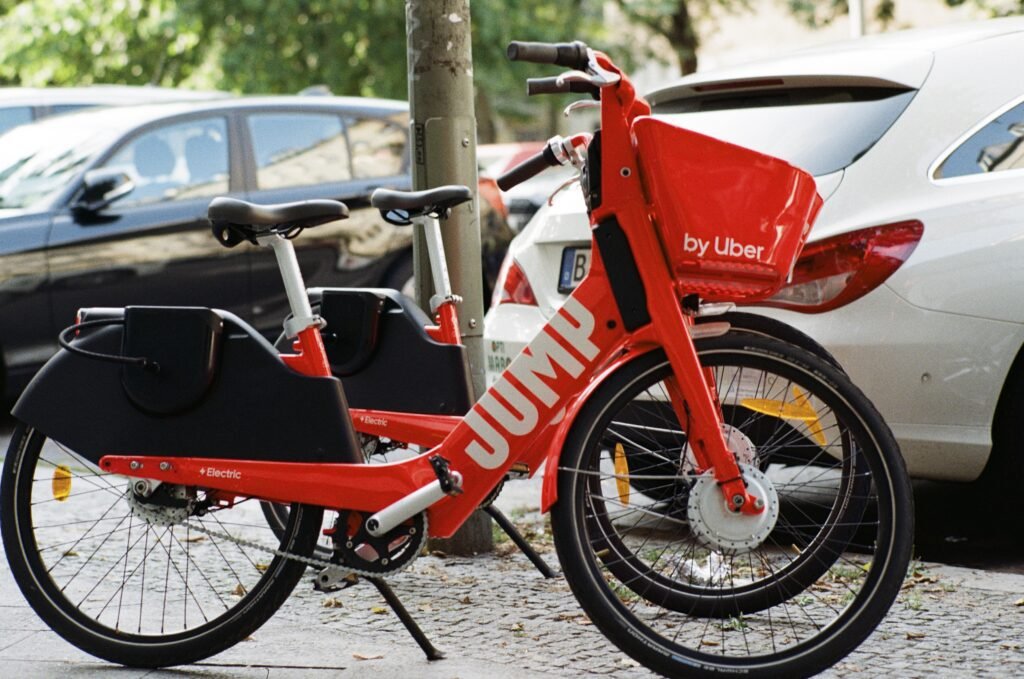Looking for a sustainable and convenient way to get around? Researchers have been studying the impact of e-bikes on mobility and the results are fascinating. From the rise in e-bike sales fueling record-breaking ridership for bike rental platforms to the growing popularity of e-bikes over electric cars, it’s clear that these electric-powered bicycles are transforming the way we travel. With discounts and deals available during the holidays, now may be the perfect time to hop on an e-bike and experience the benefits for yourself. With less impact on the environment than cars and an array of new tools and accessories being released, e-bikes are not only an efficient mode of transportation but also a fun and sustainable way to commute. Scientists are continuing to delve into the effects of e-bikes on mobility, and as more research and advancements come to light, it’s exciting to see how this innovative mode of transportation will shape the future.

Benefits of E-bikes
Reduced demand for oil
One of the biggest advantages of e-bikes is their ability to reduce the demand for oil. With over 280 million electric bikes and mopeds in the world, their impact on cutting the demand for oil is significant. In fact, studies show that electric bikes are reducing the demand for oil more than electric cars. This is a positive step towards reducing our reliance on fossil fuels and moving towards a more sustainable future.
Sustainability and environmental impact
In addition to reducing the demand for oil, e-bikes also have a positive impact on the environment. Compared to cars, e-bikes produce significantly fewer emissions, helping to reduce air pollution and combat climate change. With their electric motors, e-bikes offer a greener transportation alternative that can contribute to a more sustainable and eco-friendly future.
Cheaper and more convenient commuting
Commuting can be expensive and time-consuming, but e-bikes offer a cheaper and more convenient alternative. With an e-bike, you can avoid traffic congestion, parking fees, and the high cost of fuel. E-bikes also allow for easier parking in crowded urban areas, as they can be locked up just like regular bicycles. Additionally, e-bikes can provide a faster commute, as they can navigate through traffic more efficiently, especially during peak hours.
Increasing popularity over electric cars
While electric cars have gained popularity in recent years, e-bikes are quickly becoming a preferred mode of transportation for many individuals. E-bikes offer a practical solution for short commutes and urban travel. Their affordability, ease of use, and lower maintenance costs make them an attractive option for a growing number of people. As e-bike technology continues to advance and become more accessible, their popularity is only expected to increase further.
Safety Concerns
Speeding issues
One of the safety concerns associated with e-bikes is the issue of speeding. With their electric motors, e-bikes can reach higher speeds than traditional bicycles, allowing riders to travel at a faster pace. While this can be advantageous in some situations, it can also increase the risk of accidents if riders are not cautious. It’s important for e-bike riders to be aware of their speed and ride responsibly, especially in crowded areas or on busy roads.
Potential accidents and collisions
Like any mode of transportation, there is always a risk of accidents and collisions when riding an e-bike. Factors such as distracted driving, inadequate infrastructure, and the behavior of other road users can contribute to these risks. To minimize the chances of accidents, it’s crucial for e-bike riders to follow traffic rules, wear protective gear, and stay vigilant while on the road. Additionally, proper education and awareness campaigns can help promote safe riding practices and reduce the likelihood of accidents.
Regulations and restrictions
As e-bikes become more popular, governments and municipalities are implementing regulations and restrictions to ensure the safety of riders and other road users. These regulations may include speed limits, helmet requirements, and limitations on where e-bikes can be ridden. It’s important for e-bike riders to familiarize themselves with the regulations in their area and adhere to them to avoid any legal issues and promote a safe riding environment for everyone.
Research Findings
Impact on mobility patterns
Researchers have been studying the impact of e-bikes on mobility patterns, and the findings are quite promising. E-bikes have been shown to increase the range and frequency of travel for individuals, allowing them to access areas that may have been previously difficult to reach. This increased mobility can have a positive impact on people’s quality of life, as it provides them with more opportunities for work, recreation, and social activities.
Changes in commuting behavior
E-bikes have also been found to have a significant influence on commuting behavior. Many individuals who previously commuted by car or public transportation have switched to e-bikes due to their convenience and cost-effectiveness. This shift in commuting behavior can lead to decreased congestion on roads, reduced emissions, and a more efficient transportation system.
Accessibility and inclusivity
The accessibility of e-bikes has also been a subject of research, and the findings are encouraging. E-bikes have been shown to be a more inclusive mode of transportation, as they require less physical effort compared to traditional bicycles. This makes them a viable option for individuals who may have physical limitations or find it challenging to ride a regular bike. The accessibility of e-bikes can help promote active transportation among a wider range of people and contribute to a more inclusive society.
Effect on public transportation usage
Studies have also examined the effect of e-bikes on public transportation usage. While some may assume that e-bikes would compete with public transportation, research has shown that the two can actually complement each other. E-bikes can serve as a first or last-mile solution, allowing individuals to easily access public transportation hubs. This integration of e-bikes and public transportation can enhance the overall efficiency and accessibility of the transportation network.
E-bike Technology
Open-source motor controller development
In the world of e-bike technology, open-source motor controller development has been a significant development. This allows for greater customization and innovation, as developers can freely access and modify the motor controller software. With open-source motor controllers, e-bike enthusiasts and manufacturers can create unique riding experiences and optimize their e-bike’s performance.
New tools and accessories for e-bikes
As e-bikes continue to gain popularity, there has been a surge in the development of new tools and accessories specifically designed for e-bikes. These include smartphone apps for tracking and monitoring performance, GPS navigation systems tailored for e-bike routes, and specialized racks and panniers for carrying cargo. The availability of these tools and accessories enhances the overall e-biking experience and provides added convenience for riders.
Integration of advanced features
E-bike technology is constantly evolving, and manufacturers are integrating advanced features into their models. This includes features such as regenerative braking, which utilizes the motor’s energy to recharge the battery during braking, and smart connectivity options that allow riders to connect their e-bikes to their smartphones or other devices. These advanced features not only enhance the performance and functionality of e-bikes but also contribute to a more seamless and interactive riding experience.

E-bike Sales and Discounts
Record-breaking ridership for bike rental platforms
The rise in e-bike popularity has led to record-breaking ridership for bike rental platforms. Companies like POGO have seen a significant increase in the number of users renting e-bikes for commuting and leisure purposes. This trend indicates a growing demand for e-bikes and reflects the shift towards more sustainable and efficient modes of transportation.
Holiday discounts and deals
During the holiday season, e-bike manufacturers and retailers often offer discounts and deals to attract customers. These holiday promotions make e-bikes more affordable and accessible to a wider range of individuals. Whether it’s a Black Friday sale or a Cyber Monday deal, these discounts provide an opportunity for potential e-bike buyers to take advantage of reduced prices and enjoy the benefits of e-bike ownership.
Impacts on the market
The increasing popularity of e-bikes and the steady growth in sales have had a significant impact on the market. Manufacturers are recognizing the demand for e-bikes and are investing in research and development to introduce new models with innovative features. Additionally, the growing market has opened up opportunities for new players to enter the industry, creating a competitive landscape that benefits consumers with a wider range of options and better pricing.
Government Assistance Programs
Available assistance programs
Various government assistance programs exist to promote the adoption of e-bikes. These programs provide financial incentives, tax credits, or subsidies to individuals or businesses purchasing e-bikes. The availability of these assistance programs can alleviate the initial cost barrier associated with e-bike ownership and encourage more people to embrace this sustainable mode of transportation.
E-bike voucher programs in specific locations
In some locations, e-bike voucher programs have been implemented to further promote the use of e-bikes. These programs provide eligible individuals with vouchers that can be redeemed for discounted or free e-bikes. By targeting specific regions or communities, e-bike voucher programs aim to increase e-bike adoption among those who may benefit the most, such as low-income individuals or individuals with limited transportation options.
Benefits and outcomes
Government assistance programs for e-bikes have had positive outcomes, both for individuals and the environment. By making e-bikes more affordable, these programs enable more people to switch from traditional gasoline-powered vehicles to e-bikes. This reduces emissions, improves air quality, and contributes to a sustainable and greener future. Additionally, the increased adoption of e-bikes can also lead to reduced traffic congestion and associated costs, as well as improved overall public health due to increased physical activity.

Regulations and Bans
Bans on e-bikes at colleges
In some instances, e-bikes have been banned at colleges and university campuses. These bans are typically put in place due to concerns about safety and overcrowding on campus pathways. While the intention is to ensure the safety of pedestrians and cyclists, it has sparked debates about the appropriate regulations and management strategies that universities should implement to accommodate the growing popularity of e-bikes while maintaining safety and order on campus.
Possible license requirements for e-bikes and e-scooters in NYC
In New York City, there have been discussions about implementing license requirements for e-bikes and e-scooters. The proposed regulations aim to improve safety and ensure that riders are operating these vehicles responsibly. The introduction of license requirements would require riders to undergo training and education, helping to mitigate potential risks associated with inexperienced or reckless riders. However, these proposals have faced criticism from some advocacy groups who argue that such regulations could limit the accessibility and affordability of e-bikes and e-scooters.
E-bikes and Commuter Habits
Changing commuting patterns
E-bikes have had a significant impact on commuting patterns, with many individuals shifting from traditional modes of transportation to e-bikes. The convenience, cost-effectiveness, and environmental benefits of e-bikes have encouraged people to reconsider their commuting habits. As a result, there has been a noticeable increase in the number of e-bike commuters, especially in urban areas where traffic congestion and parking difficulties are common.
Increasing adoption in different communities
E-bikes have gained popularity in various communities, appealing to a diverse range of individuals. From urban professionals to retirees, e-bikes offer a mode of transportation that suits different lifestyles and needs. Additionally, e-bikes have been adopted by communities that face transportation challenges, including the elderly and individuals living in rural areas. The ability to travel longer distances with less physical exertion makes e-bikes a practical and inclusive transportation option.
Comparison to other transportation modes
When comparing e-bikes to other transportation modes, they offer unique advantages. Compared to cars, e-bikes are more affordable, produce fewer emissions, and require less infrastructure investment. They also provide health benefits by promoting physical activity. While public transportation offers convenience and accessibility, e-bikes provide a more flexible and personalized commuting experience. Ultimately, the choice between e-bikes and other transportation modes depends on individual preferences, distance traveled, and the availability of infrastructure.

Future of E-bikes
Ongoing research and studies
The future of e-bikes looks promising, with ongoing research and studies exploring various aspects of e-bike technology and usage. Researchers are investigating ways to enhance e-bike performance, optimize battery efficiency, and improve safety features. Additionally, studies are being conducted to understand the impacts of e-bikes on public health, urban planning, and transportation systems. The insights gained from these research efforts will further contribute to the development and advancement of e-bike technology.
Technological advancements and innovations
As e-bike technology continues to evolve, we can expect to see technological advancements and innovations in the coming years. These could include improvements in battery technology, allowing for longer ride distances, faster charging, and increased overall performance. We may also see advancements in connectivity, with e-bikes integrating with smart city infrastructure to provide real-time data and personalized riding experiences. With the continuous innovation in the e-bike industry, the future holds exciting possibilities for both manufacturers and riders.
Market projections and growth potential
The e-bike market is projected to experience significant growth in the coming years. As more individuals recognize the benefits of e-bikes and governments promote sustainable transportation options, the demand for e-bikes is expected to rise. Market forecasts point towards increasing sales, expansions into new regions, and the introduction of more affordable models. This growth potential signifies a shift towards more sustainable and efficient modes of transportation, and highlights the bright future of e-bikes.
Conclusion
In conclusion, e-bikes offer numerous benefits, ranging from reducing the demand for oil and promoting sustainability to providing cheaper and more convenient commuting options. However, safety concerns, regulations, and bans must be addressed to ensure the safe integration of e-bikes into our transportation systems. Ongoing research and studies are shedding light on the impact of e-bikes on mobility patterns, commuting behavior, and public transportation usage. Technological advancements and innovations, along with government assistance programs, are further driving the adoption of e-bikes. As the market continues to grow and market projections indicate promising growth potential, e-bikes are poised to play a significant role in shaping the future of transportation. By considering the impact of e-bikes and promoting sustainable mobility, policymakers and urban planners can create a more efficient and environmentally-friendly transportation landscape.


